| No. | Portrait | Governor | From | Until | Secretary of the Indies [2] | Valido Secretary of the Universal Bureau First Secretary of State | Regent | Monarch |
|---|
| 1 |  | Blasco Núñez Vela | 15 May 1544 | 18 January 1546 | Vacant (Overseas Affairs hold by the President of the Council of the Indies) | No valido | No regency |  Charles I |
| Int. |  | Pedro de la Gasca , Dean of the Audiencia | 10 April 1547 | 27 January 1550 |
| 2 |  | Antonio de Mendoza , Marquis of Mondéjar, Count of Tendilla | 23 September 1551 | 21 July 1552 |
| Int. |  | Melchor Bravo de Saravia , Dean of the Audiencia | 21 July 1552 | 29 June 1556 |
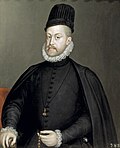 Philip II |
| 3 |  | Andrés Hurtado de Mendoza, 3rd Marquis of Cañete | 29 June 1556 | 30 March 1561 |
| 4 |  | Diego López de Zúñiga, 4th Count of Nieva | 17 April 1561 | 20 February 1564 |
| Int. |  | Juan de Saavedra , Dean of the Audiencia | 20 February 1564 | 2 September 1564 |
| Int. |  | Lope García de Castro , Dean of the Audiencia | 2 September 1564 | 26 November 1569 |
| 5 |  | Francisco Álvarez de Toledo | 26 November 1569 | 23 September 1581 |
| 6 |  | Martín Enríquez de Almanza | 23 September 1581 | 13 March 1583 |
| Int. |  | Cristóbal Ramírez de Cartagena , Dean of the Audiencia | 13 March 1583 | 31 March 1584 |
| 7 |  | Fernando Torres de Portugal y Mesía , 1st Count of Villadompardo | 31 March 1584 | 20 November 1589 |
| 8 |  | García Hurtado de Mendoza, 5th Marquis of Cañete | 8 January 1590 | 24 July 1596 |
| 9 |  | Luis de Velasco, Marquis of Salinas | 24 July 1596 | 18 January 1604 |
 Duke of Lerma [3] |  Philip III |
| 10 |  | Gaspar de Zúñiga, 5th Count of Monterrey | 18 January 1604 | 16 March 1606 |
| Int. |  | Diego Núñez de Avendaño , Dean of the Audiencia | 16 March 1606 | 21 December 1607 |
| 11 |  | Juan de Mendoza, 3rd Marquis of Montesclaros | 21 December 1607 | 18 December 1615 |
| 12 |  | Francisco de Borja y Aragón , Count of Rebolledo, Prince of Esquilache | 18 December 1615 | 31 December 1621 |
 Cristóbal Gómez de Sandoval [3] |
 Philip IV |
 Baltasar de Zúñiga [3] |
| Int. |  | Juan Jiménez de Montalvo , Dean of the Audiencia | 31 December 1621 | 25 July 1622 |
| 13 |  | Diego Fernández de Córdoba, Marquis of Guadalcázar, Count of Posadas | 25 July 1622 | 14 January 1629 |
 Count-Duke of Olivares [3] |
| 14 |  | Luis Jerónimo de Cabrera, 4th Count of Chinchón | 14 January 1629 | 18 December 1639 |
| 15 |  | Pedro de Toledo, 1st Marquis of Mancera | 18 December 1639 | 20 September 1648 |
 Luis de Haro [3] |
| 16 |  | García Sarmiento de Sotomayor, 2nd Count of Salvatierra | 20 September 1648 | 24 February 1655 |
| 17 |  | Luis Enríquez de Guzmán, 9th Count of Alba de Liste | 24 February 1655 | 31 December 1661 |
| No valido [4] |
| 18 |  | Diego de Benavides, 8th Count of Santisteban del Puerto, 1st Marquis of Solera | 31 December 1661 | 16 March 1666 |
 Juan Everardo Nithard [3] | 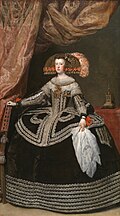 Mariana of Austria [5] Mariana of Austria [5] |  Charles II |
| Int. |  | Bernardo de Iturriaza , Dean of the Audiencia | 17 March 1666 | 21 November 1667 |
| 19 |  | Pedro Antonio Fernández de Castro, 10th Count of Lemos | 21 November 1667 | 6 December 1672 |
 Fernando de Valenzuela [3] |
| Int. |  | Bernardo de Iturriaza , Dean of the Audiencia | 6 December 1672 | 15 August 1674 |
| 20 |  | Baltasar de la Cueva, Count of Castellar | 15 August 1674 | 7 July 1678 |
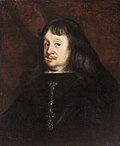 John Joseph of Austria [6] | No regency |
| 21 |  | Melchor Liñán y Cisneros (Archbishop of Lima) | 7 July 1678 | 20 November 1681 |
 Duke of Medinaceli [6] |
| 22 |  | Melchor de Navarra, Duke of Palata | 20 November 1681 | 15 August 1689 |
| Count of Oropesa [6] |
| 23 |  | Melchor Portocarrero, 3rd Count of Monclova | 15 August 1689 | 22 September 1705 |
 Cardinal Portocarrero [3] |
| Count of Oropesa [6] |
 Cardinal Portocarrero [3] |
 Cardinal Portocarrero [7] |
| Antonio de Ubilla [8] | Government Board of the Realms [9] | Vacant [10] |
 Philip V |
| Marquis of Mejorada del Campo [8] |  Cardinal Portocarrero [11] |
| No regency |
| Int. |  | Juan Peñalosa y Benavides , Dean of the Audiencia | 22 September 1705 | 7 July 1707 |
| 24 |  | Manuel de Oms, 1st Marquis of Castelldosrius | 7 July 1707 | 22 April 1710 |
| Int. |  | Miguel Núñez de Sanabria , Dean of the Audiencia | 22 April 1710 | 14 September 1710 |
| 25 |  | Diego Ladrón de Guevara | 14 September 1710 | 2 March 1716 |
| Manuel de Vadillo y Velasco [8] |
 José de Grimaldo [8] |
| Bernardo Tinajero de la Escalera [12] |
| No secretary |
| Int. |  | Mateo de la Mata Ponce de León , Dean of the Audiencia | 2 March 1716 | 15 August 1716 |
| Int. |  | Diego Morcillo Rubio de Auñón , O.SS.T. (Archbishop of Lima) | 15 August 1716 | 5 October 1716 |
| 26 |  | Carmine Caracciolo, 5th Prince of Santo Buono | 5 October 1716 | 26 January 1720 |
| 27 |  | Diego Morcillo Rubio de Auñón , O.SS.T. (Archbishop of Lima) | 26 January 1720 | 14 May 1724 |
 Miguel Fernández Durán [12] |
| Andres Matías de Pes Marazaraga [12] |
| No secretary |
| Antonio de Sopeña y Mioño [12] |
| Juan Bautista de Orendáin [8] |
 Louis I From 1700 to 1724, Philip V was the king; then from 1724 to 1746. Louis I only reigned in 1724. |
| 28 |  | José de Armendáriz, 1st Marquis of Castelfuerte | 14 May 1724 | 4 February 1736 |
 Philip V |
 José de Grimaldo [8] |
 José de Patiño y Rosales [12] |
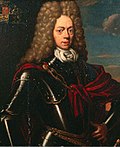 Baron Ripperda [8] |
 José de Grimaldo [8] |
| Juan Bautista de Orendáin [8] |
 José de Patiño y Rosales [13] |
| 29 |  | José Antonio de Mendoza, 3rd Marquis of Villagarcía | 4 February 1736 | 15 December 1745 |
| Mateo Pablo Díaz de Lavandero [12] |  Marquis of Villarías [13] |
 Marquis of Villarías [12] |
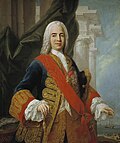 Marquess of Ensenada [12] |
| 30 |  | José Manso de Velasco, 1st Count of Superunda | 15 December 1745 | 12 October 1761 |
 Ferdinand VI |
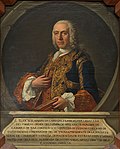 José de Carvajal [13] |
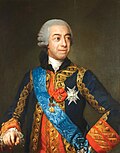 Duke of Huéscar (Interim) [13] |
 Ricardo Wall [13] |
 Ricardo Wall (Interim) [14] |
| Julián de Arriaga y Ribera [14] |
 Elisabeth Farnese [15] |  Charles III |
| No regency |
| 31 |  | Manuel de Amat y Juniet | 12 October 1761 | 17 July 1776 |
 Jerónimo Grimaldi [13] |
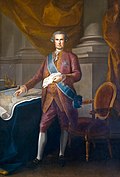 Marquess of Sonora [14] |
| 32 |  | Manuel de Guirior | 17 July 1776 | 21 July 1780 |
 Count of Floridablanca [13] |
| 33 |  | Agustín de Jáuregui | 21 July 1780 | 29 April 1784 |
| 34 |  | Teodoro de Croix | 29 April 1784 | 25 March 1790 |
 Count of Floridablanca (Interim) [14] |  Charles IV |
 Antonio Porlier [16]
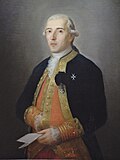 Antonio Valdés y Fernández Bazán Antonio Valdés y Fernández Bazán [17] |
| 35 |  | Francisco Gil de Taboada | 25 March 1790 | 6 June 1796 |
| No secretary (affairs of Indies distributed among different secretariats) |  Count of Aranda (Interim) [13] |
 Manuel Godoy [13] |
| 36 |  | Ambrosio O'Higgins, 1st Marquis of Osorno | 24 July 1796 | 19 March 1801 |
 Francisco Saavedra [13] |
 Mariano Luis de Urquijo [13] |
 Pedro Cevallos Guerra [13] |
| Int. |  | Manuel Arredondo y Pelegrín , Dean of the Audiencia | 19 March 1801 | 5 November 1801 |
| 37 |  | Gabriel de Avilés, 2nd Marquis of Avilés | 5 November 1801 | 20 August 1806 |
| 38 |  | José Fernando de Abascal y Sousa , 1st Marquis of La Concordia [18] | 20 August 1806 | 7 July 1816 |
 Gonzalo O'Farril [13] |
 Pedro Cevallos Guerra [13] |  Ferdinand VII |
| Martín Garay Perales (Interim) [13] |
 Eusebio Bardají y Azara [13] |
| Pedro Rivero (Interim) [13] |
 Francisco Saavedra [13] |
| Nicolás Ambrosio Garro y Arizcun(Interim) [13] |
 José García de León y Pizarro (Interim) [13] |
| Ignacio de la Pezuela (Interim) [13] |
 Ciriaco González Carvajal(Interim) [19] |  Carlos Martínez de Irujo [13] |
 Pedro Gómez Labrador [13] |
| José Limonta (Interim) [19] |
| Antonio Cano Ramírez de Arellano(Interim) [13] |
| Manuel Antonio de la Bodega y Mollinedo [19] |
 Juan O'Donojú (Interim) [13] |
 Miguel de Lardizabal [20] |  José Miguel de Carvajal-Vargas [13] |
| No secretary |
 Pedro Cevallos Guerra [13] |
| Juan Estebán Lozano de Torres [13] |
 Pedro Cevallos Guerra |
| 39 |  | Joaquín de la Pezuela, 1st Marquis of Viluma | 7 July 1816 | 29 January 1821 |
 José García de León [13] |
 Carlos Martínez de Irujo (Interim) [13] |
 Manuel González Salmón (Interim) [13] |
 Joaquín José Melgarejo [13] |
| Antonio González Salmón(Interim) [19] |
| Juan Jabat Aztal [13] |
 Antonio Porcel Román [19] Antonio Porcel Román [19] |
 Evaristo Pérez de Castro [13] |
| Ramón Gil de la Cuadra [19] |
| 40 |  | José de la Serna e Hinojosa , 1st Count of los Andes | 29 January 1821 | 9 December 1824 |
| Antonio de Guilleman(Interim) [21] | Joaquín Anduaga Cuenca (Interim) [13] |
| Francisco de Paula Escudero (Interim) [13] |
| Ramón Olaguer Feliú [21] |
 Eusebio Bardají y Azara [13] |
| Ramón López Pelegrín [21] |
| Ramón López Pelegrín [13] |
 José Gabriel de Silva y Bazán [13] |
| Ramón López Pelegrín [13] |
| Manuel de la Bodega Mollinedo [21] |  Francisco Martínez de la Rosa [13] |
 Diego Clemencín [21] |
| José Manuel de Vadillo [21] |
| Evaristo Fernández San Miguel y Valledor [13] |
| José Manuel Vadillo [13] |
| Pedro Urquinaona [21] | Santiago Usoz y Mozi [13] |
| José María Pando de la Riva y Ramírez de Laredo [13] |
| Francisco de Paula Ossorio y Vargas (Interim) [21] |
| Luis María de Salazar y Salazar [13] |
| Juan Antonio Yandiola Garay [13] |
| José Luyando [13] |
| No secretary |
| Víctor Damián Sáez [13] |
 Carlos Martínez de Irujo [13] |
 Narciso Heredia [13] |
 Francisco Cea Bermúdez [13] |
| 41 |  | Juan Pío de Tristán y Moscoso | 9 December 1824 | 30 December 1824 [22] |














































































































